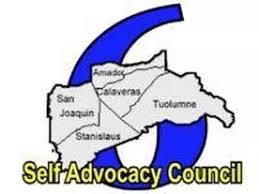About Self Advocacy Council 6

The SAC6 was created in May, 1992 by self advocates with a grant from State Council on Developmental Disabilities (SCDD) through then Area Board 6 now called SCDD – North Valley Hills — Amador, Calaveras, San Joaquin, Stanislaus, and Tuolumne counties. Two representatives from each self advocacy chapter in Area 6 can serve on the SAC6 board. Area 6 has representatives on the Valley Mountain Regional Center Board, the State Council on Developmental Disabilities (SCDD) North Valley Hills Office, the Statewide Self-Advocacy Network (SSAN), and the Department of Developmental Services (DDS) Consumer Advisory Committee (CAC).
The representative of the Department of Developmental Services Consumer Advisory Committee is also a member of the SAC6. The elected leadership for SAC6 includes:






The mission of the SAC6 is:
-
- Learn about issues that impact the lives of people with developmental disabilities.
- Tell the self-advocacy groups about important issues.
- Find out what the self-advocacy groups think about important issues.
- Find out what self-advocates want in their lives.
- Talk to people who make decisions for people with developmental disabilities, including VMRC and Area Board, and tell them what advocates want.
- Help the self-advocacy movement grow!
Upcoming Events
- Here’s the latest from Dr. Dave Demetral’s talk on July 10, 2020:
- Be Kind to Your Mind
Tips to cope with stress during COVID-19  1 PAUSE. Breathe.
1 PAUSE. Breathe.
Notice how you feel Think before you speak
In the heat of the moment, it’s easy to say something you’ll later regret. Take a few moments to collect your thoughts before saying anything — and allow others involved in the situation to do the same. 2, Once you’re calm, express your anger
2, Once you’re calm, express your anger
As soon as you’re thinking clearly, express your frustration in an assertive but nonconfrontational way. State your concerns and needs clearly and directly, without hurting others or trying to control them. 3, TAKE BREAKS from COVID-19 content.
3, TAKE BREAKS from COVID-19 content.
Turn off your TV, cell phone, computer.4, MAKE TIME to sleep and exercise

 5, REACH OUT and stay connected; phone a friend; join a zoom class, do Sac 6 zoom meetings.
5, REACH OUT and stay connected; phone a friend; join a zoom class, do Sac 6 zoom meetings.- 6, Get some exercise

Physical activity can help reduce stress that can cause you to become angry. If you feel your anger escalating, go for a brisk walk or run, or spend some time doing other enjoyable physical activities. 7, Take a timeout
7, Take a timeout
Timeouts aren’t just for kids. Give yourself short breaks during times of the day that tend to be stressful. A few moments of quiet time might help you feel better prepared to handle what’s ahead without getting irritated or angry. - 8, Identify possible solutions

Instead of focusing on what made you mad, work on resolving the issue at hand. What could you, or they, do that might work better? Call one of us for “idea help”.  9, Stick with ‘I’ statements
9, Stick with ‘I’ statements
To avoid criticizing or placing blame — which might only increase tension — use “I” statements to describe the problem. Be respectful and specific. For example, say, “I’m upset that you said you were going to call me and you did not”, try saying, “I really like it when you call, so if you cannot be sure try to not say you are going to call and then get to busy, OK?10, Let It Go!!!! Don’t hold a grudge

Forgiveness is a powerful tool. If you allow anger and other negative feelings to crowd out positive feelings, you might find yourself swallowed up by your own bitterness or sense of injustice. But if you can forgive someone who angered you, you might both learn from the situation and strengthen your relationship. 11, Use humor to release tension
11, Use humor to release tension
Lightening up can help diffuse tension. Use humor to help you face what’s making you angry and, possibly, any unrealistic expectations you have for how things should go. Avoid sarcasm, though — it can hurt feelings and make things worse.- 12, Practice relaxation skills

When your temper flares, put relaxation skills to work. Practice deep-breathing exercises, imagine a relaxing scene, or repeat a calming word or phrase, such as “Take it easy.” You might also listen to music, write in a journal or do a few yoga poses — whatever it takes to encourage relaxation. Know when to seek help
Know when to seek help
Learning to control anger is a challenge for everyone at times. Seek help for anger issues if your anger seems out of control, causes you to do things you regret or hurts those around you. You all can call me at 209-623-7716, or call Rose, or Jazzie, Ed, or Devon and they will get ahold of me to contact you. - Only members of self-advocacy groups are members of SAC6 board. SAC6 also publishes a newsletter called
- The Chatter: August 2024
- The Chatter: February 2024
- The Chatter: September 2021
- The Chatter: April 2021
- The Chatter: August 2020
- The Chatter: May 2020
- The Chatter: Fall 2019
- The Chatter: Spring 2019
Coronavirus Resources
All Things Coronavirus Presentation – From May 8, 2020 SAC6 Zoom Chat
Coronavirus Scams and Fraud Alert 2020
Coronavirus Scams and Fraud Alert 2020 (Spanish)
Recent Events
- SAC6 Board Meeting: Saturday, December 14, 2019
- SAC6 Leadership Meeting: Monday, January 13, 2020 (officers only)
- SAC6 Area Meeting: Friday, February 7, 2020
Additional Resources:
- SAC6 Brochure
- Consumer Advocate Information and Form
- SAC6 Fact Sheet
- Amazon Smile Sheet
- SAC6 Office Hours
